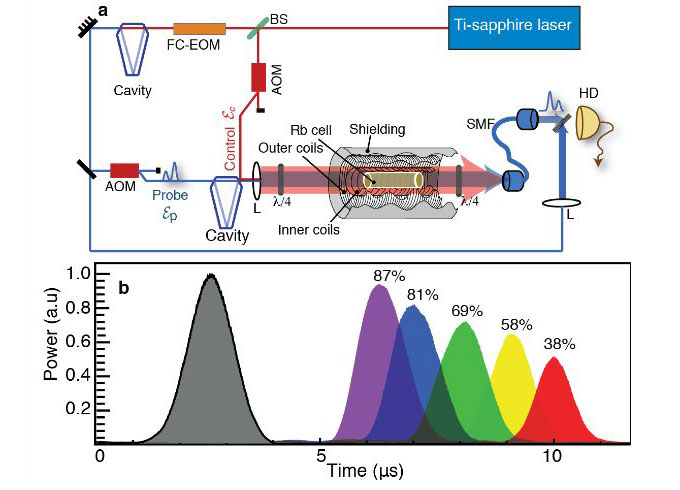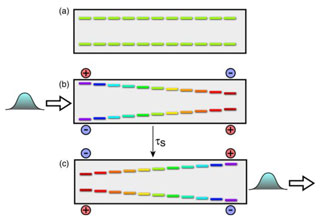Normal, classical optical signals are carried by changing the amplitude of the light and the signal may be detected simply with a photodetector. In this case a piece of paper, or a computer hard-drive could be used to store the information carried on the light. You can use the stored data to drive a laser and recreate the amplitude signal with which you started.
In a quantum information scenario, however, information may be encoded on the amplitude and phase of the light. With weak, quantum limited signals, Heisenberg's uncertainty principle means that you may not simultaneously measure the amplitude and phase of your light without disturbing your signals. To store quantum information, you need to actually store the light itself without measuring it. If you measure it, the information will be lost.
The goal of our work is to map states of light into the excitation of clouds of atoms. When the light is absorbed into the atoms, they can store the full quantum information of the input light. With a few tricks, it is possible to un-absorb the light at a later time. To do this we use a technique known as the Gradient Echo Memory (GEM).
GEM is a coherent light storage technique based on photon echoes. The idea was first demonstrated in a 2-level atomic system by the solid state group at the ANU. Our GEM experiment is based on a 3-level system in hot rubidium vapour. The best efficiency in warm vapour we have seen is 87%, as shown in Figure 1.

Figure 1. a: A schematic of the experiment. b: Recall efficiency up to 87% is achieved. From Nature Communications 2,174 (2011)
The storage mechanism works as shown in Figure 2. An ensemble of two level atoms (a) is frequency shifted (b) to create a gradient of atomic frequencies along the length of the ensemble. The frequency width of the atomic sample is adjusted to capture the entire bandwidth of the optical pulse. After flipping the frequency gradient at time ts, a photon echo is generated at time 2ts (c). In our case the two levels we use in this system are the hyperfine ground states of rubidium that form a quasi-2-level system under the influence of a strong control field. The atomic frequency gradient is formed using a magnetic field.
The storage of a light in this system can be understood using a normal mode description. This is a combined oscillation of the atomic polarisation and optical field. Figure 3 shows the real parts of the optical field (left) and atomic polarisation (middle) and the magnitude of the normal mode (right). The normal mode of our system is described in the spatial Fourier domain. Whenever the normal mode reaches k=0, light can be coupled out of our memory. The motion of the normal mode is controlled by the frequency gradient in our atomic sample.

Figure 2: (a) An ensemble of 2-level atoms. (b) Atoms shifted to form a linear frequency gradient that can aborb a light pulse. (c) Flipping the gradient causes a photon echo.

Figure 3: Left column shows the optical field, middle column is the atomic polarisation and right is the k-space polariton. From Phys. Rev. Lett. (2008) vol.101, 203601
Our 3-level GEM scheme can also be used to recall stored optical information on demand, split stored information over multiple recall events and control the temporal width of a recalled information. There are two important control knobs that help us to do this. The first is the atomic frequency gradient that moves the k-space normal mode in the t-k plane. Every time the normal mode passes through the k=0 point, the atoms are rephased and a photon echo can be produced. The second knob is the control field that couples the two atomic ground states. Only when the control field is on can a photon echo be produced. In this way we can control exactly when and how much of each stored pulse is recalled. An example of this capability is shown in Figure 4.

Figure 4: Pulses 1-7 are stored then we recall (4,3) at t=15. Pulses 5 and 6 are recalled at t=27. Pulses 1 and 2 are spilt and partially recalled at three different times, also with compression and expansion.
One way to understand this system is to imagine the normal mode as an optical conveyer belt to which the pulses of light are stuck. By changing the magnetic field we can control the direction and speed of the belt. With careful control of the magnetic field, therefore, we can move the pulses back and forth through the k=0 point. Every time the pulses pass through this point, we can use the control field to push them off the belt and out of the memory.
Using laser cooled atoms we can increase the storage time of the memory and maintain our efficiency. Figure 7 shows a comparison of our experiment to other techniques around the world.

Figure 7: Comparison of memory techniques from Optica 3, 100 (2016).